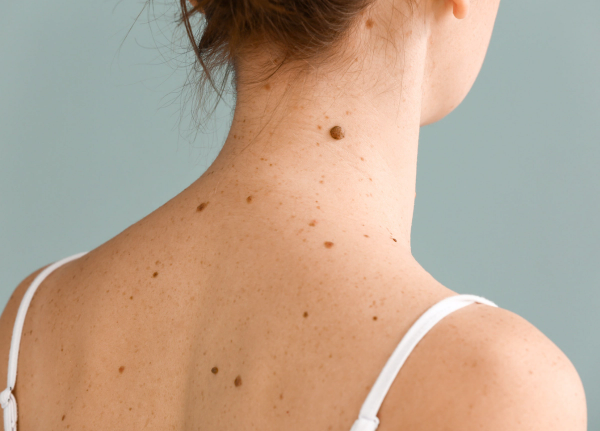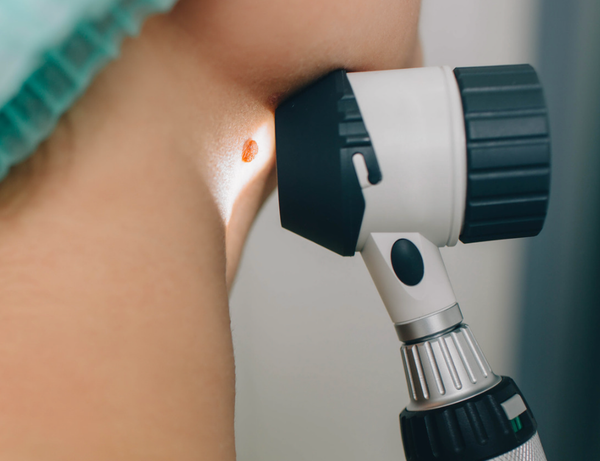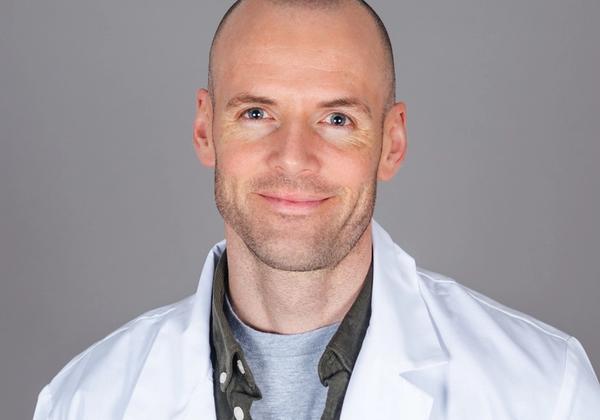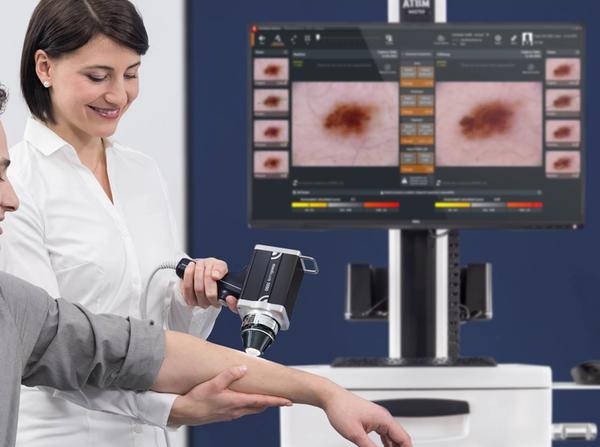Mole removal
Worried about a mole? We help you!
Moles are common, but sometimes they can be a sign of skin cancer.
At Dr. Dropin, we offer thorough examination and safe removal of moles by experienced dermatologists.
Book dermatologist nowWorried about a mole? We help you!
Moles are common, but sometimes they can be a sign of skin cancer.
At Dr. Dropin, we offer thorough examination and safe removal of moles by experienced dermatologists.
Book dermatologist nowChanges in size, shape or colour: A mole that grows, changes shape, gets jagged edges or changes color should be examined by a dermatologist.
Itching, bleeding or soreness: Moles that itch, bleed or become sore can also be signs of problems.
New moles: New moles that appear after the age of 30 should also be assessed by a dermatologist.

Consultation with a dermatologist: One of our experienced dermatologists will examine the mole carefully with a dermatoscope and assess whether it should be removed.
Removal: If removal is necessary, this is done gently with local anaesthetic. We use surgical techniques to ensure the best possible cosmetic result.
Analysis: The removed mole is sent for laboratory analysis to rule out skin cancer. You will receive an answer within 1-2 weeks.
Book dermatologist appointment
Experienced dermatologists: Our dermatologists have extensive experience in diagnosing and treating skin diseases, including mole cancer.
Quick and easy appointment booking: Book an appointment online or via our app, and get an appointment quickly.
Safe and professional: We follow strict hygiene standards and use modern equipment to ensure safe and effective treatment.

Early diagnosis and treatment of skin cancer is essential.
Book an appointment with one of our dermatologists today to get a thorough assessment of your moles.
Les mer om FotoFinder
It is important to be aware of moles, especially when there are many or large moles. Frequent checks are recommended, for example annual checks or when changes are detected. This is especially important if you have:
A significant number of moles, especially over 50, measuring more than 2 mm in diameter.
Several large moles, with a diameter of more than 7 mm, which have an uneven shape and varied colors.
A family history of mole cancer, especially if parents or siblings have been affected.
Prolonged sun exposure without adequate UV protection, especially if you have experienced sunburn.
Being aware of these risk factors and seeking medical help when necessary can contribute to early detection and treatment of potential skin problems.
It is important to be aware of moles, especially when there are many or large moles. Frequent checks are recommended, for example annual checks or when changes are detected. This is especially important if you have:
A significant number of moles, especially over 50, measuring more than 2 mm in diameter.
Several large moles, with a diameter of more than 7 mm, which have an uneven shape and varied colors.
A family history of mole cancer, especially if parents or siblings have been affected.
Prolonged sun exposure without adequate UV protection, especially if you have experienced sunburn.
Being aware of these risk factors and seeking medical help when necessary can contribute to early detection and treatment of potential skin problems.
Self-monitoring of moles is a good practice to detect any changes in time. However, if you notice changes, it is important to seek professional help from a dermatologist or general practitioner for a more thorough assessment.
Self-monitoring of moles is a good practice to detect any changes in time. However, if you notice changes, it is important to seek professional help from a dermatologist or general practitioner for a more thorough assessment.
See below for a checklist for when you should see a dermatologist or general practitioner for a consultation.
- You get a new mole
- A mole changes shape and colour, by
- Becomes larger than before, in thickness or in width
- Changes shape and gets uneven edges
- Changes colour, often with brown-black parts
- A mole itches, bleeds or forms a wound that will not heal
See below for a checklist for when you should see a dermatologist or general practitioner for a consultation.
- You get a new mole
- A mole changes shape and colour, by
- Becomes larger than before, in thickness or in width
- Changes shape and gets uneven edges
- Changes colour, often with brown-black parts
- A mole itches, bleeds or forms a wound that will not heal
A new mole is not dangerous in itself. Most new moles appear early in life and up to the age of 25, but they can also appear after this. New moles most often appear on skin areas exposed to the sun. If the new mole has signs such as uneven color and shape, an uneven surface, itches, sores or bleeding, you should have it checked by a dermatologist or general practitioner.
A new mole is not dangerous in itself. Most new moles appear early in life and up to the age of 25, but they can also appear after this. New moles most often appear on skin areas exposed to the sun. If the new mole has signs such as uneven color and shape, an uneven surface, itches, sores or bleeding, you should have it checked by a dermatologist or general practitioner.
Unfortunately, we cannot control whether we get more moles or not, as they are primarily genetic and can also be affected by exposure to sunlight and other environmental factors. However, it is important to protect the skin from excessive sun exposure by using sunscreen with a high SPF, avoiding sunburn, and wearing protective clothing and sunglasses when outdoors in bright sunlight. This can help reduce the risk of developing new moles and other skin problems.
Unfortunately, we cannot control whether we get more moles or not, as they are primarily genetic and can also be affected by exposure to sunlight and other environmental factors. However, it is important to protect the skin from excessive sun exposure by using sunscreen with a high SPF, avoiding sunburn, and wearing protective clothing and sunglasses when outdoors in bright sunlight. This can help reduce the risk of developing new moles and other skin problems.
A FotoFinder mole check is an advanced skin examination that uses digital technology to map and monitor moles and other skin changes. By photographing the entire body, FotoFinder can detect small changes over time, which is crucial for the early detection of skin cancer.
A FotoFinder mole check is an advanced skin examination that uses digital technology to map and monitor moles and other skin changes. By photographing the entire body, FotoFinder can detect small changes over time, which is crucial for the early detection of skin cancer.
FotoFinder allows you to compare images of your skin over time, providing accurate monitoring of moles. This is especially important for early detection of changes that could indicate skin cancer and for individuals with numerous moles or a history of skin cancer.
FotoFinder allows you to compare images of your skin over time, providing accurate monitoring of moles. This is especially important for early detection of changes that could indicate skin cancer and for individuals with numerous moles or a history of skin cancer.
A mole check with FotoFinder is recommended for individuals with many moles, those with fair skin that easily burns, or people with a family history of skin cancer. It is also beneficial for those who want thorough monitoring of their skin's condition.
A mole check with FotoFinder is recommended for individuals with many moles, those with fair skin that easily burns, or people with a family history of skin cancer. It is also beneficial for those who want thorough monitoring of their skin's condition.
During a FotoFinder mole check, a dermatologist will first manually examine your moles. The entire body is then photographed with the FotoFinder system, creating a digital map of your skin. This map is used to monitor moles over time.
During a FotoFinder mole check, a dermatologist will first manually examine your moles. The entire body is then photographed with the FotoFinder system, creating a digital map of your skin. This map is used to monitor moles over time.
No, a mole check with FotoFinder is completely painless. It involves only photographing the skin and is a non-invasive procedure.
No, a mole check with FotoFinder is completely painless. It involves only photographing the skin and is a non-invasive procedure.
A typical mole check with FotoFinder takes about one hour. This includes a thorough examination by a dermatologist and full-body photography with the FotoFinder system.
A typical mole check with FotoFinder takes about one hour. This includes a thorough examination by a dermatologist and full-body photography with the FotoFinder system.
The frequency of mole checks with FotoFinder depends on your individual risk of skin cancer. People at high risk should consider having their moles checked annually or more often, while those at lower risk might do so every other year.
The frequency of mole checks with FotoFinder depends on your individual risk of skin cancer. People at high risk should consider having their moles checked annually or more often, while those at lower risk might do so every other year.
FotoFinder is a tool that helps dermatologists identify suspicious moles that may be skin cancer. It does not provide a diagnosis but allows for the identification of moles that require further examination or biopsy.
FotoFinder is a tool that helps dermatologists identify suspicious moles that may be skin cancer. It does not provide a diagnosis but allows for the identification of moles that require further examination or biopsy.
If FotoFinder identifies a suspicious mole, the dermatologist will recommend further examinations, which may include a biopsy to determine whether the mole is cancerous.
If FotoFinder identifies a suspicious mole, the dermatologist will recommend further examinations, which may include a biopsy to determine whether the mole is cancerous.
To prepare for a mole check with FotoFinder, avoid applying makeup or creams to your skin on the day of the examination. It is also important to inform the dermatologist of any previous skin issues or concerns you may have.
To prepare for a mole check with FotoFinder, avoid applying makeup or creams to your skin on the day of the examination. It is also important to inform the dermatologist of any previous skin issues or concerns you may have.
No, FotoFinder is painless and harmless.
No, FotoFinder is painless and harmless.
Yes, FotoFinder is safe for pregnant and breastfeeding women.
Yes, FotoFinder is safe for pregnant and breastfeeding women.
Your dermatologist will be able to advise you on this based on your individual risk and skin condition.
Your dermatologist will be able to advise you on this based on your individual risk and skin condition.
Moles Oslo | Moles Bergen | Moles Stavanger | Mole check Oslo | Mole check Bergen | Mole check Stavanger | Dermatologist moles Oslo | Dermatologist moles Bergen | Dermatologist moles Stavanger | Removal of moles Oslo | Removal of moles Bergen | Removal of moles Stavanger | Dr. Dropin moles Oslo | Dr. Dropin moles Bergen | Dr. Dropin moles Stavanger | Skin cancer Oslo | Skin cancer Bergen | Skin cancer Stavanger | Melanoma Oslo | Melanoma Bergen | Melanoma Stavanger | Dermatoscopy Oslo | Dermatoscopy Bergen | Dermatology Stavanger | Skin changes Oslo | Skin changes Bergen | Skin changes Stavanger | Book appointment dermatologist Oslo | Book appointment dermatologist Bergen | Book an appointment with a dermatologist in Stavanger.